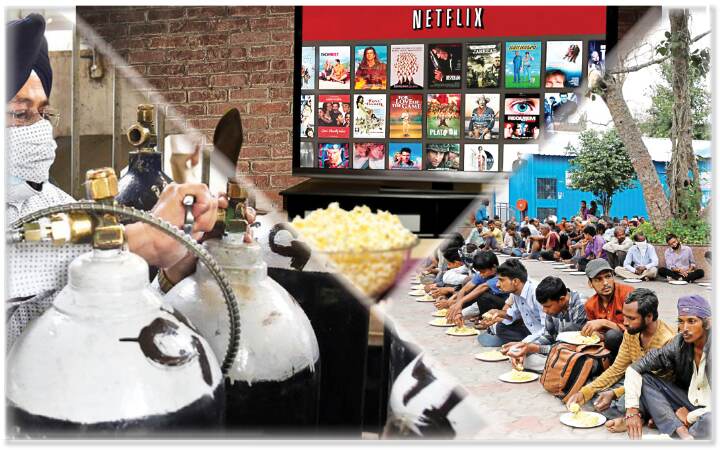What are we up to now?
Apparently, not up to a whole lot of good. Today, as a vast majority of Indians find themselves stuck inside their homes yet again, what with curfews and lockdowns returning to our lives, a lot of us are resorting to things less than significant. But can you really blame us that much, especially when we are scared and petrified?

What triggers yet another in(s)ane and senseless column from my laptop, you ask, in the midst of the chaos and mayhem that we live in today? Well, it was triggered by a phone call from a former heart-throb of mine, one of the very many who haven't deigned to reach out to me for years. The lady pinged me at 3 am in the morning last night. In my mind, I went ooh-la-la, and then more la, la, la, and finally, a delectable and serenaded la-la-la.
Why? Well, why not? My fast-disappearing youth was making a guest (re-)appearance, making the stars shine bright and vivid. My two cats, loveable yet nocturnal, given their genes, were blessedly prostrate and belly-up, their little feline paws flailing in the air as they dreamt their tiny cat fantasies. My two cuddly dogs were snoring their heads off, their pink tongues hanging out without a care in a soporific world. And most important, the missus was fast asleep, though not snoring. Yes. Yeah. Yeaaaa!
So it was that I dove in head-first into an expected telephonic love-fest. But oops, for I was jolted by a cheesy, rather tinsel voice from my re-doubtable past that bleated in my ear: "Do you have Crocin, Raju? My third child needs some. No one has any, and I knew you would be up."
Thus are dreams torn asunder, in one shattering, cacophonic moment – this was one such. As is every moment for over a billion Indians now, with our dreams, hopes and life itself going helter-skelter, making us cower in our homes 24x7. How do we spend these 24 hours each day today? I decided to do some digging.
TV binge watching
After I fixed the Paracetamol quest of the ex, my life moved on nonchalantly. To what, you ask? The television, of course, what else... And we are watching a lot of it. Get a load of this – in the first wave of the COVID-19 pandemic, once India was all locked up, news channels became our sole window to the external world. That triggered a massive jump of 27 per cent in viewership, and that was just a trailer. As the lockdown extended, so did our fear and anxiety, amid a total paucity of things to do to while away each day's 24 hours. A lot more of India took to Amazon Prime, Disney Hostar, VOOT, Netflix and what-have-you.
The then-growth numbers were staggering, with popular OTT TV apps registering a hockey stick rise in viewership, a mind-boggling jump of 400-500 per cent in just the first two months of the lockdown in April and May of 2020. And ever since, the numbers are only north-bound, with the average Indian middle-class household (four members included) spending 31 hours out of the 24 hours in a day watching something or the other on TV – that defies both mathematics and physics.
But wait, there is an irony to this story, because we are Indians. As we began indulging more, annual subscription charges started hurting our pockets, so we began sharing passwords with family and friends. The result? Even Netflix founder and Chairman Reed Hastings, in an Earnings Call, cited dipping revenue numbers despite rising subscribers, and even went on to say that the investment in India remained speculative. "In India, in-vestments take guts and belief in (being) forward-looking. But… content exports well, and we're just getting a little better at it every month." Indian 'jugaad' at play – welcome to my world, Netflix.
Liquor and indulgence
When we are chained to our chairs and bed, constantly churned by fear and anxiety, and no one to monitor our activities, some inevitably reach for the bottle, hitting the elixir that Bacchus introduced us to. COVID only made this more rampant. In times as bad as we are facing today, many cast care and fears aside to greedily clutch that slim bottle neck or grab the wide brim of the glass.
Liquor (should we be polite and call it an 'alcoholic beverage'?) is an intrinsic part of Indian lives and lifestyles now. Some months back, a report in Lancet revealed that liquor consumption per adult per year in India went up by 38 per cent between 2010 and 2017 – up from 4.3 liters to 5.9 liters – predominantly on the back of freer familial and cultural values, as also the inclusion of a greater number of women in the drinkers' list.
Multiply that per-person consumption by India's adult population for the period under review, of over 50 crore, and you get a whiff of the sheer scale and numbers involved.
The 'Fourth Wave' sees Indians well and truly hooked to alcohol, especially as we remain locked behind closed doors. Even earlier, many tended to reach for the glass at the end of the day, to 'welcome' the evening. Some did it because they liked it, others because it was a way to cope, others still because they wanted to blend in. COVID has seen those in Category III graduate to Categories I or II. And newer ones are joining Category III. The dance goes on; the number of dancers is increasing. We are embracing tippledom like never before. Remember the queues outside liquor shops when Delhi Chief Minister Arvind Kejriwal declared the new lockdown around 20 days back? There's your story.
Telephone and Zoom
Aha! My new best (only?) friend, my telephone… Before the pandemic, I would speak to my friends once in a couple of days, for a few minutes and then move on to other things. COVID changed all that and there is now a 'Comfort Club' for each one of us – an identified set of people that we speak to for hours each day. Earlier, after a quick chat a few times a week, we would meet up. Now, with nothing much to do in our 24 hours, the phone is turning into our best friend.
Paradoxically, it is also turning into our worst enemy, as a research by Stanford University has revealed. As offices downed shutters, video conferences took the place of in-person meetings as a means to stay connected with co-workers. However, these video calls quickly led to a new level of employee burnout. So much so that we now have manuals on how to deal with stress caused by calls made on apps such as Zoom, Skype, Teams, Messenger or FaceTime. Let's not blame the apps; for they are only helping us. The problem lies with us.
A research paper found out that when we are in an in-person meeting, we have the opportunity to look away from others in the room. In a video conference, our eye contact is always on with everyone else on the call. If we look away, it might seem like we are not paying attention; plus, de-pending on the screen size, team member's faces appear larger than in real life, which is intense and unnatural. Cause for discomfort…
Exercise regimen
What exercise?! While many of us repeatedly promise ourselves that we will work out and get fitter, especially given that we have far more flexibility in our schedules today, few are actually hitting the gym or the road / park. Why's that? Well, two simple reasons – one, gyms and the road / park are not a good place to be, for they are outside the house, and 'outside' isn't very attractive now. Two, we are just worried sick and getting lazy. Bar a few examples, each one of us knows many upon many friends who have put on ounces and kilos, and centimeters and inches in all the wrong places.
And that is extremely ironical because we are being bombarded by news reports on how 'Health' app downloads are hitting new highs. Health app downloads have increased by about 20 per cent in the last two months alone, while others have seen a surge of as much as 50 per cent since mid-February. Lockdowns and curfews, work from home norms, isolation and high-stress have spurred the notional need for mental and physical well-being. But the ground reality is different. Very few are actually exercising. Even home treadmills are waiting in vain for some exercise, but to no avail.
Dashboard and support
A few weeks back, I wrote about our magical Indian Sardars (Sikhs) and the miracles they can pull off, on their own or collectively, as a community. I am happy to share that others have joined the ranks in these dark days. Muslims are stepping in now, as mosques across India turn into COVID care centers. Hindus are following suit, as temples turn into hospitals, with beds and ready oxygen supplies.
With the authorities cutting a sorry figure and playing the blaming-game in court houses across the land, it is religious places and the discarded common man who are rising to the occasion. Government-backed apps provide outdated information, but those run by private citizens are hitting the social media with a vengeance. They are always up to date, give or take a few hours, and provide real-time information on the availability of beds, oxygen cylinders, Remdesivir and Fabiflu, and even information on crematoriums and cemeteries with open slots.
What a twist of fate COVID-19 and (-20 and -21?) have exposed us to. Earlier, private individuals had to manage their families, jobs and lives. We have now reached a crossroads where we are forced to manage even death and its attendant mechanics and complications. What a travesty.
The writer is a communications consultant and a clinical analyst. [email protected] Views expressed are personal



